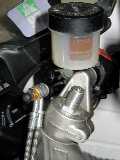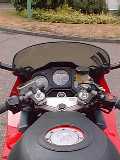| Measurement | Comments | |
| 791mm | VFR750FL extended fork length (center of axle to top of stanchion tube) | |
| - | 778mm | VTR1000F extended fork length (center of axle to top of stanchion tube) |
| ———— | ||
| = | 13mm | difference in extended length between VFR and VTR forks |
| 39mm | distance from top of triple clamp to top of stanchion tube on stock VFR750FL | |
| - | 13mm | difference in length between VFR and VTR |
| ———— | ||
| = | 26mm | distance from top of triple clamp to top of stanchion tube with the VTR forks mounted in the same relative position as the stock VFR forks |
| 26mm | available length of stanchion tube projecting above VFR750FL triple clamp | |
| - | 33mm | thickness of VFR750FL clip-ons |
| ———— | ||
| = | (7mm) | distance from top of VFR clip-ons to top of VTR stanchion tube (they do not clear) |
| (7mm) | distance deficit to be made up | |
| 5mm | typical amount VFR forks are raised in the triple clamps | |
| + | 2mm | thickness of the VTR fork cap |
| ———— | ||
| = | 0mm | installed distance between top of VFR750FL clip-on and top of VTR1000F fork cap |
There are three further considerations, however. The four-piston NISSIN brake calipers use a 14mm master cylinder, whereas the RC36 has a 12.7mm master cylinder. Although this difference is not great, the master cylinders should also be swapped in order to preserve the VTR's brake lever ratio. In addition, the VSource.org VFR750 uses the front wheel from a later ('94-'97) RC36 (which is similar to, but not identical to, the CBR600F3's front wheel). The wheel from the VTR would also work, but it is a three-spoke design, so it wouldn't match the VFR's rear wheel. As was evident from a test fitting, the early RC36 front wheel probably doesn't actually need to be replaced for the swap to work, but note that the brake disks are not the same thickness (although they appeared to be mounted in the same relative position).
The final consideration is related to the front fender. The VFR and VTR forks have different fender mounting lug positions, so in order to use the original VFR front fender, spacers and some short brackets would need to be fabricated. As it happens, the VTR's red paint is the same as the early RC-36's "Italian red" (the Honda paint color code is R-157), so the easiest solution was simply to find a VTR front fender and use that. The countour of the VTR fender doesn't precisely match the styling of the rest of the bike, but it is very doubtful anyone will ever notice!
In conclusion, this swap isn't the most radical you can attempt, but it is a relatively easy upgrade to make. Most of the difficulty involved getting accurate measurements and determining exactly what would and would not fit. Yes, CBR900RR forks would have been more adjustable, but the fork tubes are larger and the forks are probably too short for the VFR. People who have done this type of swap report having to modify the fork stops (presumably because the forks would otherwise hit something...), which decreases steering lock. CBR600F4 forks would probably have been long enough, but again, have a larger diameter. CBR600F3 forks are the same diameter as the VFR's forks, but offer no braking improvement. As anyone who has ever ventured down this sort of path knows, there are many advantages to a true "bolt-on" swap...
| Copyright © VSource.org 1999-2005 |

